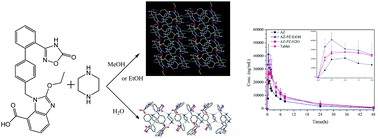Azilsartan piperazine salt solvate and monohydrate: preparation, crystal structure, enhanced solubility and oral bioavailability†
Abstract
Two azilsartan–piperazine salt solvates with methanol (Az–Pz·MeOH) and ethanol (Az–Pz·EtOH) and a hydrate (Az–Pz·H2O) have been prepared and exhaustively characterized by physicochemical methods. The crystal structures suggest that one azilsartan transfers one proton from the carboxylic group to piperazine to form 2-D corrugation-like structures in Az–Pz·MeOH and Az–Pz·EtOH, and transfers two protons from carboxylic and oxadiazolyl groups to piperazine to form a 1-D chain structure in Az–Pz·H2O. The salt solvates and hydrate are very stable after 24 h slurry experiments in distilled water at 37 °C, and improve the azilsartan solubility with approximately a 322-fold increase for Az–Pz·H2O and a 140-fold increase for Az–Pz·MeOH and Az–Pz·EtOH over that of the free Az form. The pharmacokinetic experiments show that Az–Pz·EtOH and Az–Pz·H2O improve the plasma azilsartan concentration Cmax and AUC (P < 0.05) over the free Az form in Sprague-Dawley rats. The most incredible result is that Az–Pz·H2O features bioequivalence to an azilsartan tablet (Azilva®, P > 0.05). The research demonstrates that the pharmaceutical salt is a promising approach in increasing the solubility and enhancing the oral bioavailability of low-solubility azilsartan.



 Please wait while we load your content...
Please wait while we load your content...